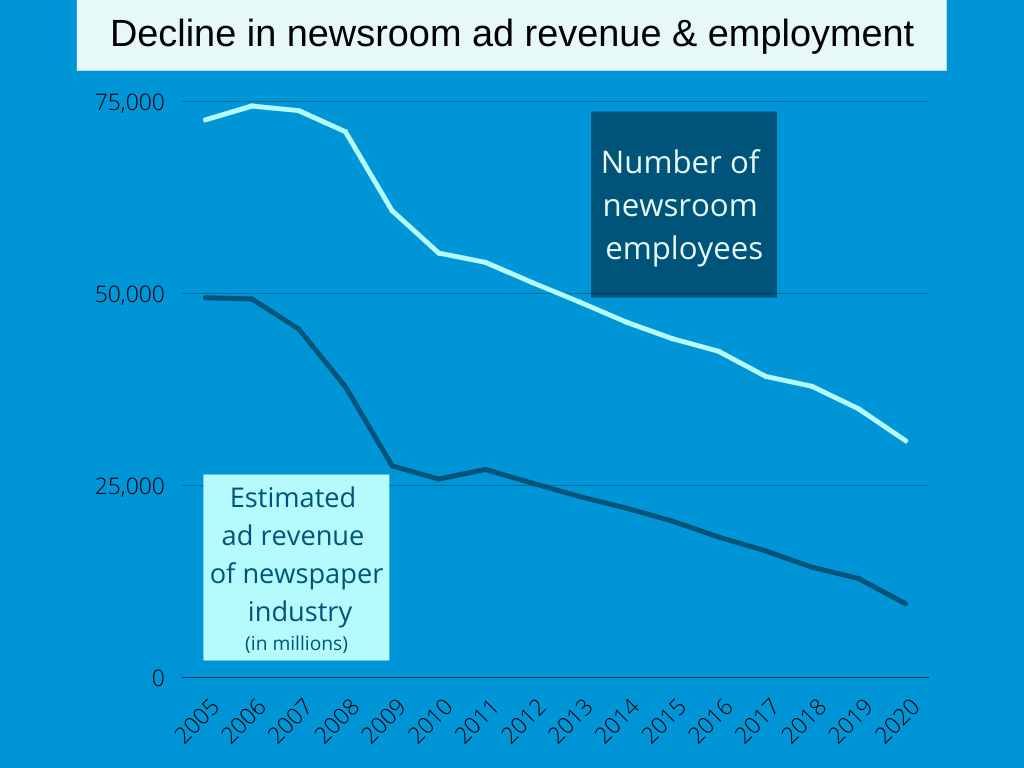
You will find Provo’s last independent newspaper in a mall, lodged between a tie shop and optometry center, its brightly lit desks and desktop computers awkwardly exposed to the busy shoppers passing by.
Like many small newspapers, the Daily Herald has undergone dramatic changes in the wake of the internet’s creative destruction, including a sharp reduction in newsroom size and capacity.
These changes are, according to Herald employees, indicative of a much larger trend. Indeed, this office—missing its fourth wall during Provo Towne Centre’s business hours—is a window into an entire industry, they say.
However, this grim backdrop serves to highlight the efforts of Daily Herald employees to inform Utah County motivated by their love for community and an abiding faith in the value of local journalism
“I wanted to come out here and be in communities, help people and learn every day,” said Harrison Epstein, the paper’s editor.
While having no delusions about the difficulty of the career path he has chosen, the 25-year-old editor-in-chief is optimistic about the paper’s future and committed to its role in the community.
After graduating in 2019 with a degree in journalism from Weber State University and working for two years in small newsrooms in Wyoming and Utah, Epstein was surprised to be promoted to his current position.
“There was an opening, and I was apparently the person they saw fit to take over the Herald,” he said. “A very whirlwind kind of change.”

Hired at a time of heavy transition, with the paper leaving its old office in downtown Provo and having just lost two reporters to higher paying jobs, Epstein feels like he was given the daunting task of breathing new life into the business.
“I’m going to be responsible for a new generation for the Daily Herald, no matter what,” Epstein said.
Epstein recognizes that to survive the Daily Herald must adapt quickly to the shifting media environment that has made it so hard for traditional newspapers to keep up.
“There’s no way to look at the state of journalism and say, ‘We need to keep going the way we have,” he said, because, as he readily admits, the way local journalism has been going does not look good.
A revenue problem
Between 2005 and 2020, the estimated advertising revenue of the U.S. newspaper industry fell from $49.4 billion to $9.6 billion, according to Pew Research. This represents a decrease of 80% in 15 years. Just between 2019 and 2020 there was 25% drop in revenue, according to the same data.
Understandably, such a decline in revenue has had a harsh impact on newsroom investment. The number of newsroom employees fell from 72,600 to 30,820 during those 15 years, Pew Research data shows.

Unsurprisingly, the number of newspapers going out of business has also continued at a steady pace.
The decline of local journalism can largely be explained by the technological advances society has experienced over the last few decades, said Craig Conover, the Daily Herald’s retail manager.
“The way we consume information has changed so much in the past 20 years,” he said. “People want their information quickly. They want it on their phones. They want it right now and they want smaller segments of it.”
Conover has been with the Daily Herald for 20 years and before that worked as a reporter for the Springville Herald, which his family owned before it was consolidated into the Daily Herald.
Now, working as the head of the paper’s advertising arm, Conover said he has a clear view of the ills affecting the entire industry.
As people began relying on the internet as a convenient, free alternative to a newspaper subscription, advertisers realized that digital ads were a more cost-effective way to reach their audience than traditional print ads, Conover said.
This decrease in advertising and subscription revenue resulted in worse quality journalism as newsrooms shrunk in staff and resources, Conover said.
The Herald’s struggle
The Daily Herald has been hit as hard as any other local paper.
When Conover began his current position in the early 2000’s, the Herald had a daily average circulation of 45,000. That number now sits around 5,900, he said.
Like many local newspapers, the Herald has recently undergone multiple changes in ownership. The paper was sold in 2009 by its previous owner, Pulitzer, Inc., to Lee Enterprises, then changed hands again in 2016 when the paper was purchased by The Ogden Newspapers, a family-owned business based out of West Virginia.
Each acquisition has brought its own downsizing.
“The downsizing of our staff has been, to me, excruciatingly painful,” said Genelle Pugmire, a long-time Herald reporter.
Pugmire has been involved in journalism for nearly four decades, beginning with a stint as a high school correspondent for the Arizona Republic in her hometown of Prescott, Arizona.
After working at the Deseret News for 24 years, its Utah County bureau was closed and Pugmire was let go. She was then hired by the Daily Herald where she has worked since as the Provo, Orem and Faith reporter.
Having been in the business longer than some of her co-workers have been alive, Pugmire has seen the transformation of news in Utah County.
When she started at the Herald just over a decade ago, there were 120 employees, Pugmire said. Now there are 10: five reporters (three on news, two on sports) and five running the business side.

A smaller team means much more is asked of each employee, Pugmire said. “We have bigger beats we’re covering and we’re doing more and we’re putting in more hours than we’ve ever done before.”
From the middle of August 2021 to the beginning of November 2021, Pugmire was the only news reporter on staff. In a period of three weeks, she wrote nearly 25 stories trying to cover all the different beats, she said.
“I’ve given my blood and soul to the Daily Herald,” Pugmire said.
Epstein has done the same, according to Pugmire. The young editor is covering the work normally done by nine different people, Pugmire said.
Spanish Fork native Ashtyn Asay is one of the Daily Herald’s newest employees who is trying to lighten the load that has been carried by Pugmire and Epstein.
Asay graduated from Utah State University in 2020 with a degree in journalism and was hired by the Herald in October 2021 as a news reporter covering education, northern Utah County and Utah Lake.
“It’s definitely been difficult,” Asay said. “I think if we were able to get more people on our team, we could definitely cover a lot more and we could kind of work our way maybe closer to what we were.”
This same desire was echoed by Ryan Christner, the managing editor of both the Ogden Standard-Examiner and the Daily Herald. “I wish we had a staff twice as large as we do,” he said.
However, despite the difficulties facing his newspapers and the local newspaper industry generally Christner does not see the role of local newspapers going away any time soon.
“I think people are always going to want to know what my local government is doing and what events are coming up,” he said. “There’s an infinite internet out there, but only a few places telling you what’s going on in your backyard.”
Laurie Wynn, editor and publisher of the Wasatch Wave, sees local news outlets as meeting a need that communities will always have. “People still want somebody to be able to tell that local story,” Wynn said. “I have hope for the future of local journalism.”
The value of local journalism
Ed Carter, a BYU media law professor and practicing attorney, agrees that local journalism like that practiced by the Daily Herald has an essential role in creating strong local communities. It provides a public service by informing people about the local government’s decisions and the issues that affect their daily lives, he said.
“We tend to think of journalism on a national scale, but actually most of the really important journalism happens in local communities and that’s where a huge impact can be had for good,” Carter said.
Despite its value, however, the future of local journalism is far from certain, according to Carter.
“It’s not just written in stone that journalism and democracy will last forever,” Carter said. “If we actually stop believing in it and stop paying attention to it and stop supporting it, it will go away.”




